Exploring PPP, IFE Theories in International Financial Management
VerifiedAdded on 2023/06/12
|7
|1454
|355
Essay
AI Summary
This essay examines whether Purchasing Power Parity (PPP) and the Internal Fishers Effect (IFE) theoretically eliminate the need for derivatives, which are commonly used to hedge currency conversions. It discusses the Purchasing Power Parity puzzle, highlighting the short-term volatility of real exchange rates and the limitations of PPP in real-world scenarios due to factors like transportation costs and currency conversion charges. The analysis incorporates insights from various research articles, including the impact of carry trades and exchange rate risks. The essay concludes that while PPP and IFE may hold theoretically, practical challenges and currency volatilities often necessitate the use of derivatives in international financial management. Desklib offers similar solved assignments for students.
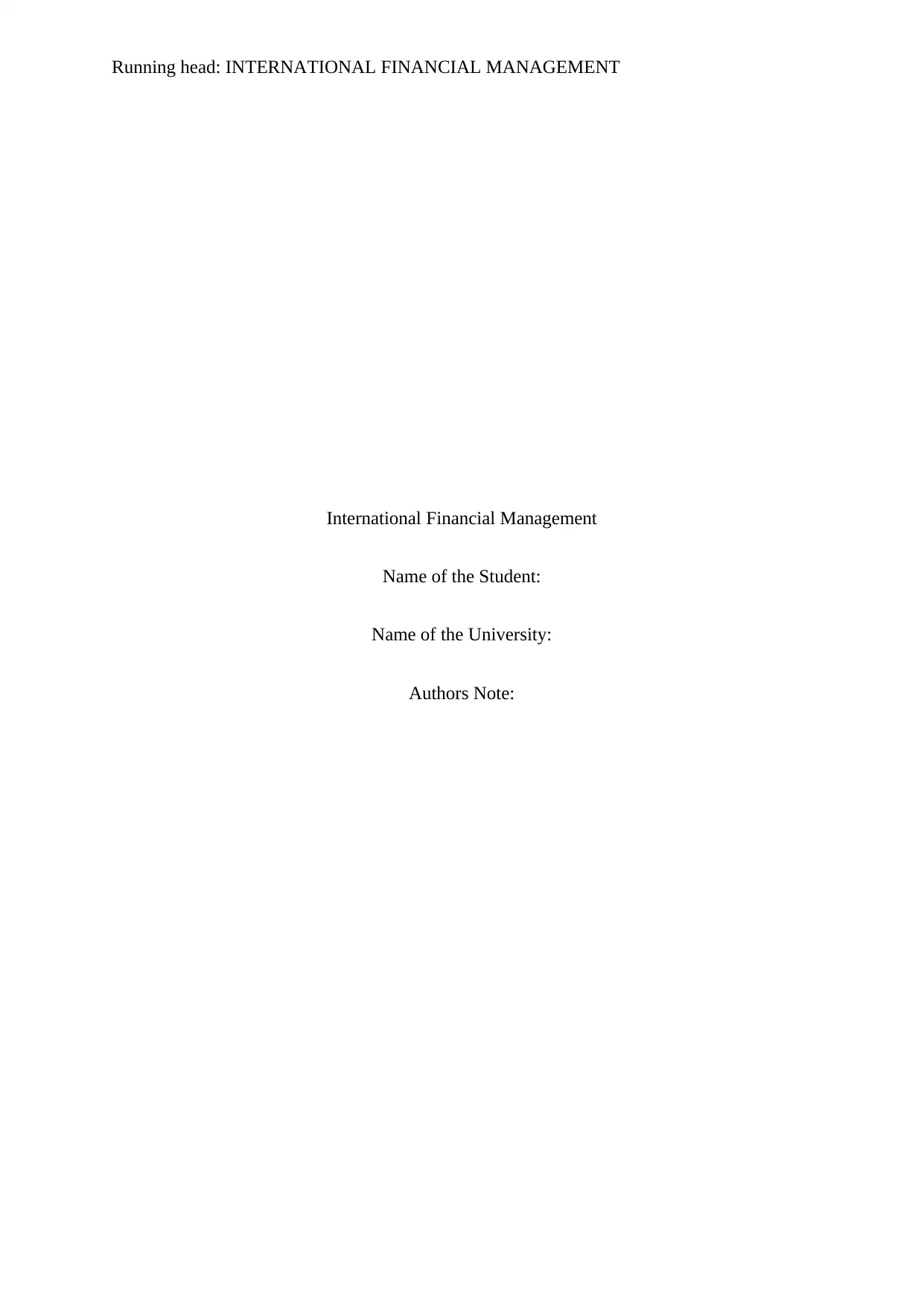
Running head: INTERNATIONAL FINANCIAL MANAGEMENT
International Financial Management
Name of the Student:
Name of the University:
Authors Note:
International Financial Management
Name of the Student:
Name of the University:
Authors Note:
Paraphrase This Document
Need a fresh take? Get an instant paraphrase of this document with our AI Paraphraser
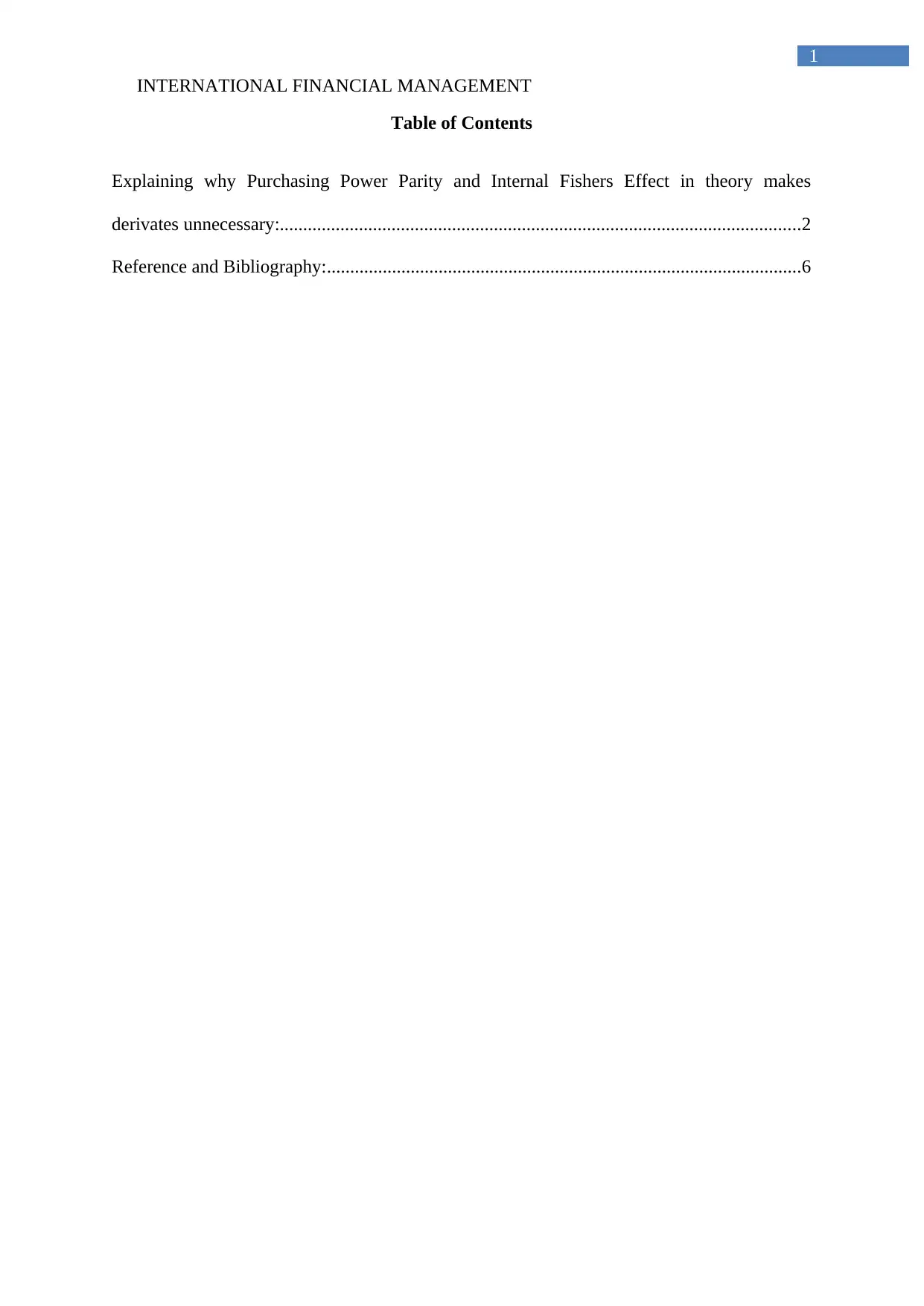
INTERNATIONAL FINANCIAL MANAGEMENT
1
Table of Contents
Explaining why Purchasing Power Parity and Internal Fishers Effect in theory makes
derivates unnecessary:................................................................................................................2
Reference and Bibliography:......................................................................................................6
1
Table of Contents
Explaining why Purchasing Power Parity and Internal Fishers Effect in theory makes
derivates unnecessary:................................................................................................................2
Reference and Bibliography:......................................................................................................6
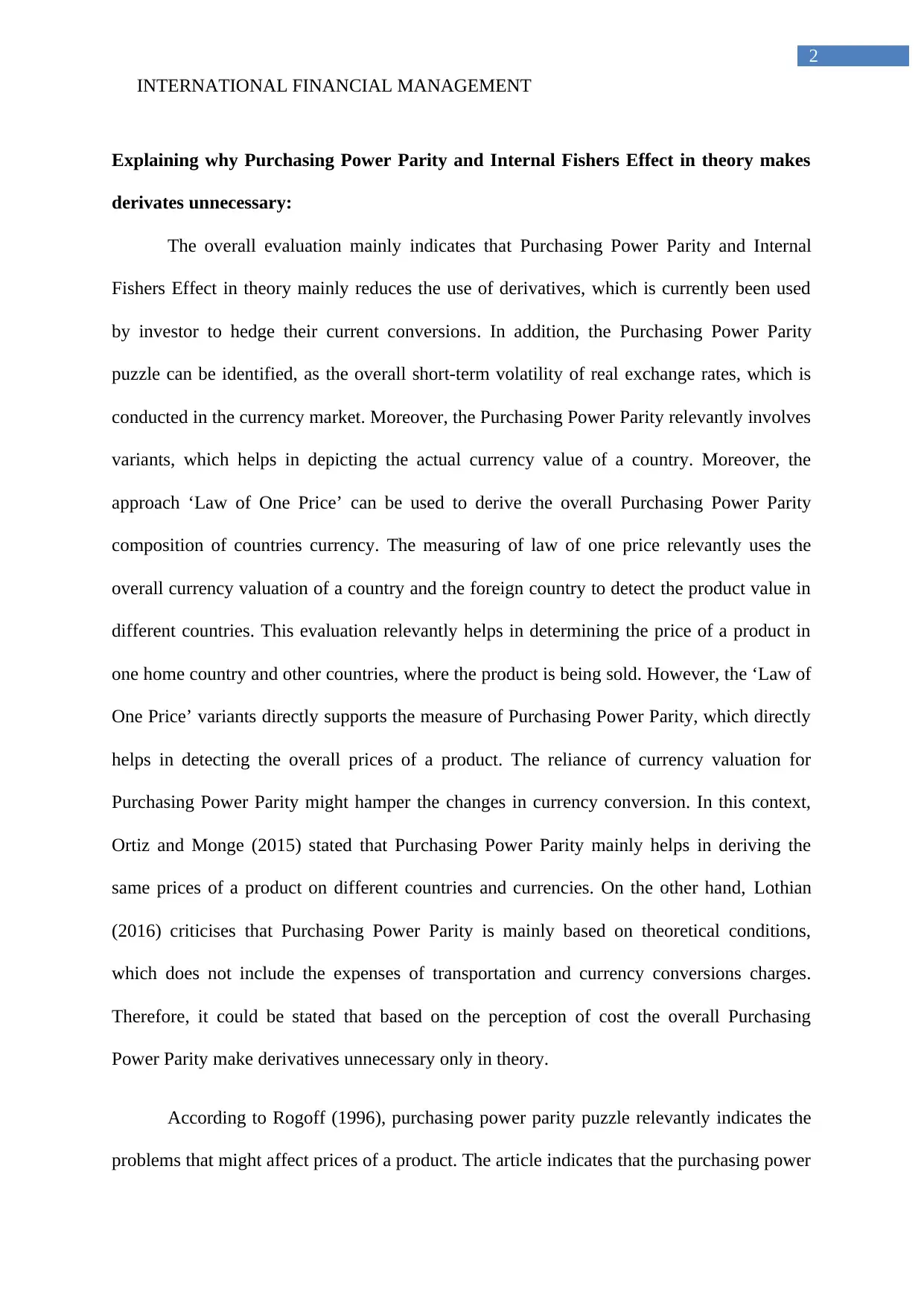
INTERNATIONAL FINANCIAL MANAGEMENT
2
Explaining why Purchasing Power Parity and Internal Fishers Effect in theory makes
derivates unnecessary:
The overall evaluation mainly indicates that Purchasing Power Parity and Internal
Fishers Effect in theory mainly reduces the use of derivatives, which is currently been used
by investor to hedge their current conversions. In addition, the Purchasing Power Parity
puzzle can be identified, as the overall short-term volatility of real exchange rates, which is
conducted in the currency market. Moreover, the Purchasing Power Parity relevantly involves
variants, which helps in depicting the actual currency value of a country. Moreover, the
approach ‘Law of One Price’ can be used to derive the overall Purchasing Power Parity
composition of countries currency. The measuring of law of one price relevantly uses the
overall currency valuation of a country and the foreign country to detect the product value in
different countries. This evaluation relevantly helps in determining the price of a product in
one home country and other countries, where the product is being sold. However, the ‘Law of
One Price’ variants directly supports the measure of Purchasing Power Parity, which directly
helps in detecting the overall prices of a product. The reliance of currency valuation for
Purchasing Power Parity might hamper the changes in currency conversion. In this context,
Ortiz and Monge (2015) stated that Purchasing Power Parity mainly helps in deriving the
same prices of a product on different countries and currencies. On the other hand, Lothian
(2016) criticises that Purchasing Power Parity is mainly based on theoretical conditions,
which does not include the expenses of transportation and currency conversions charges.
Therefore, it could be stated that based on the perception of cost the overall Purchasing
Power Parity make derivatives unnecessary only in theory.
According to Rogoff (1996), purchasing power parity puzzle relevantly indicates the
problems that might affect prices of a product. The article indicates that the purchasing power
2
Explaining why Purchasing Power Parity and Internal Fishers Effect in theory makes
derivates unnecessary:
The overall evaluation mainly indicates that Purchasing Power Parity and Internal
Fishers Effect in theory mainly reduces the use of derivatives, which is currently been used
by investor to hedge their current conversions. In addition, the Purchasing Power Parity
puzzle can be identified, as the overall short-term volatility of real exchange rates, which is
conducted in the currency market. Moreover, the Purchasing Power Parity relevantly involves
variants, which helps in depicting the actual currency value of a country. Moreover, the
approach ‘Law of One Price’ can be used to derive the overall Purchasing Power Parity
composition of countries currency. The measuring of law of one price relevantly uses the
overall currency valuation of a country and the foreign country to detect the product value in
different countries. This evaluation relevantly helps in determining the price of a product in
one home country and other countries, where the product is being sold. However, the ‘Law of
One Price’ variants directly supports the measure of Purchasing Power Parity, which directly
helps in detecting the overall prices of a product. The reliance of currency valuation for
Purchasing Power Parity might hamper the changes in currency conversion. In this context,
Ortiz and Monge (2015) stated that Purchasing Power Parity mainly helps in deriving the
same prices of a product on different countries and currencies. On the other hand, Lothian
(2016) criticises that Purchasing Power Parity is mainly based on theoretical conditions,
which does not include the expenses of transportation and currency conversions charges.
Therefore, it could be stated that based on the perception of cost the overall Purchasing
Power Parity make derivatives unnecessary only in theory.
According to Rogoff (1996), purchasing power parity puzzle relevantly indicates the
problems that might affect prices of a product. The article indicates that the purchasing power
⊘ This is a preview!⊘
Do you want full access?
Subscribe today to unlock all pages.

Trusted by 1+ million students worldwide
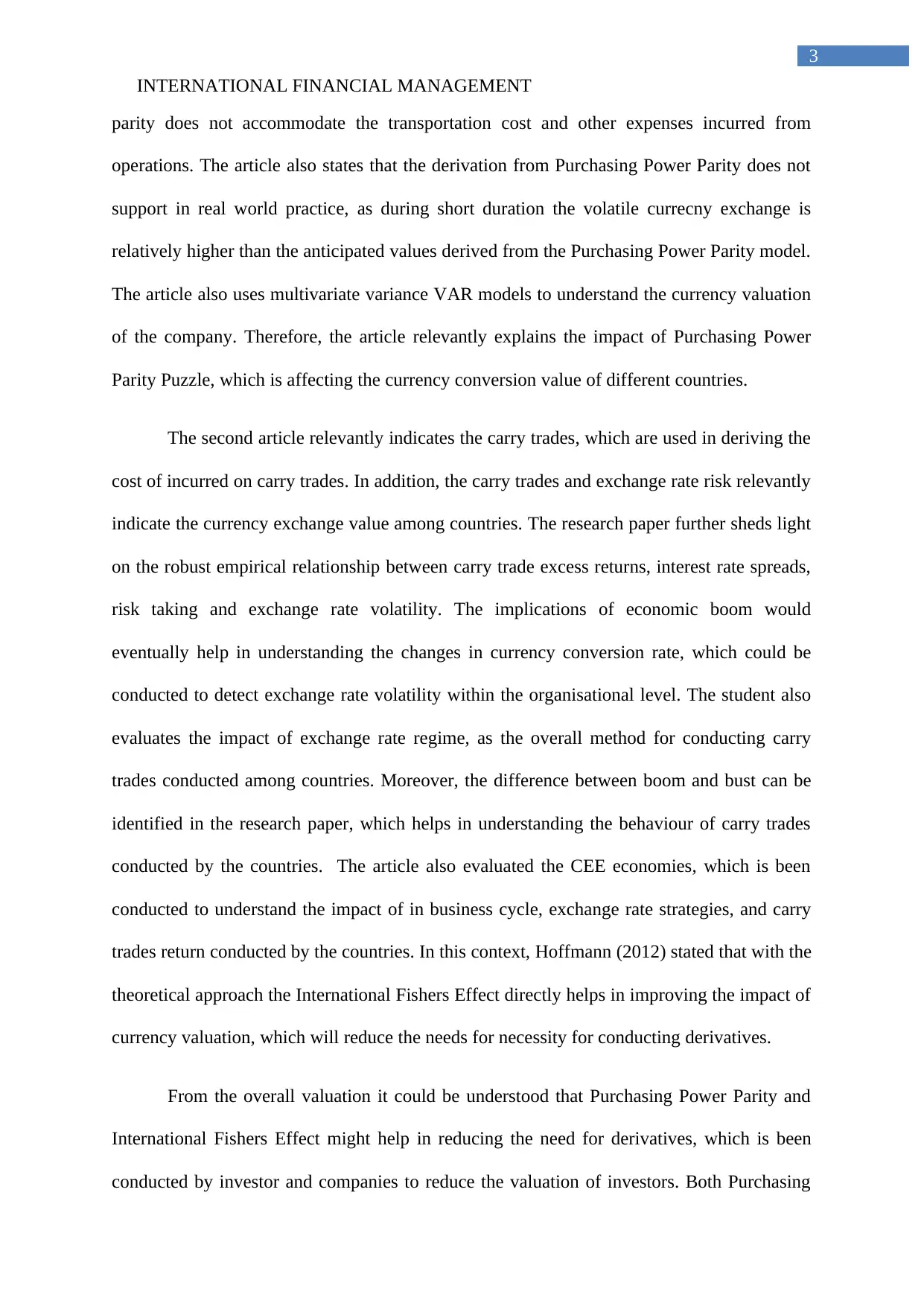
INTERNATIONAL FINANCIAL MANAGEMENT
3
parity does not accommodate the transportation cost and other expenses incurred from
operations. The article also states that the derivation from Purchasing Power Parity does not
support in real world practice, as during short duration the volatile currecny exchange is
relatively higher than the anticipated values derived from the Purchasing Power Parity model.
The article also uses multivariate variance VAR models to understand the currency valuation
of the company. Therefore, the article relevantly explains the impact of Purchasing Power
Parity Puzzle, which is affecting the currency conversion value of different countries.
The second article relevantly indicates the carry trades, which are used in deriving the
cost of incurred on carry trades. In addition, the carry trades and exchange rate risk relevantly
indicate the currency exchange value among countries. The research paper further sheds light
on the robust empirical relationship between carry trade excess returns, interest rate spreads,
risk taking and exchange rate volatility. The implications of economic boom would
eventually help in understanding the changes in currency conversion rate, which could be
conducted to detect exchange rate volatility within the organisational level. The student also
evaluates the impact of exchange rate regime, as the overall method for conducting carry
trades conducted among countries. Moreover, the difference between boom and bust can be
identified in the research paper, which helps in understanding the behaviour of carry trades
conducted by the countries. The article also evaluated the CEE economies, which is been
conducted to understand the impact of in business cycle, exchange rate strategies, and carry
trades return conducted by the countries. In this context, Hoffmann (2012) stated that with the
theoretical approach the International Fishers Effect directly helps in improving the impact of
currency valuation, which will reduce the needs for necessity for conducting derivatives.
From the overall valuation it could be understood that Purchasing Power Parity and
International Fishers Effect might help in reducing the need for derivatives, which is been
conducted by investor and companies to reduce the valuation of investors. Both Purchasing
3
parity does not accommodate the transportation cost and other expenses incurred from
operations. The article also states that the derivation from Purchasing Power Parity does not
support in real world practice, as during short duration the volatile currecny exchange is
relatively higher than the anticipated values derived from the Purchasing Power Parity model.
The article also uses multivariate variance VAR models to understand the currency valuation
of the company. Therefore, the article relevantly explains the impact of Purchasing Power
Parity Puzzle, which is affecting the currency conversion value of different countries.
The second article relevantly indicates the carry trades, which are used in deriving the
cost of incurred on carry trades. In addition, the carry trades and exchange rate risk relevantly
indicate the currency exchange value among countries. The research paper further sheds light
on the robust empirical relationship between carry trade excess returns, interest rate spreads,
risk taking and exchange rate volatility. The implications of economic boom would
eventually help in understanding the changes in currency conversion rate, which could be
conducted to detect exchange rate volatility within the organisational level. The student also
evaluates the impact of exchange rate regime, as the overall method for conducting carry
trades conducted among countries. Moreover, the difference between boom and bust can be
identified in the research paper, which helps in understanding the behaviour of carry trades
conducted by the countries. The article also evaluated the CEE economies, which is been
conducted to understand the impact of in business cycle, exchange rate strategies, and carry
trades return conducted by the countries. In this context, Hoffmann (2012) stated that with the
theoretical approach the International Fishers Effect directly helps in improving the impact of
currency valuation, which will reduce the needs for necessity for conducting derivatives.
From the overall valuation it could be understood that Purchasing Power Parity and
International Fishers Effect might help in reducing the need for derivatives, which is been
conducted by investor and companies to reduce the valuation of investors. Both Purchasing
Paraphrase This Document
Need a fresh take? Get an instant paraphrase of this document with our AI Paraphraser
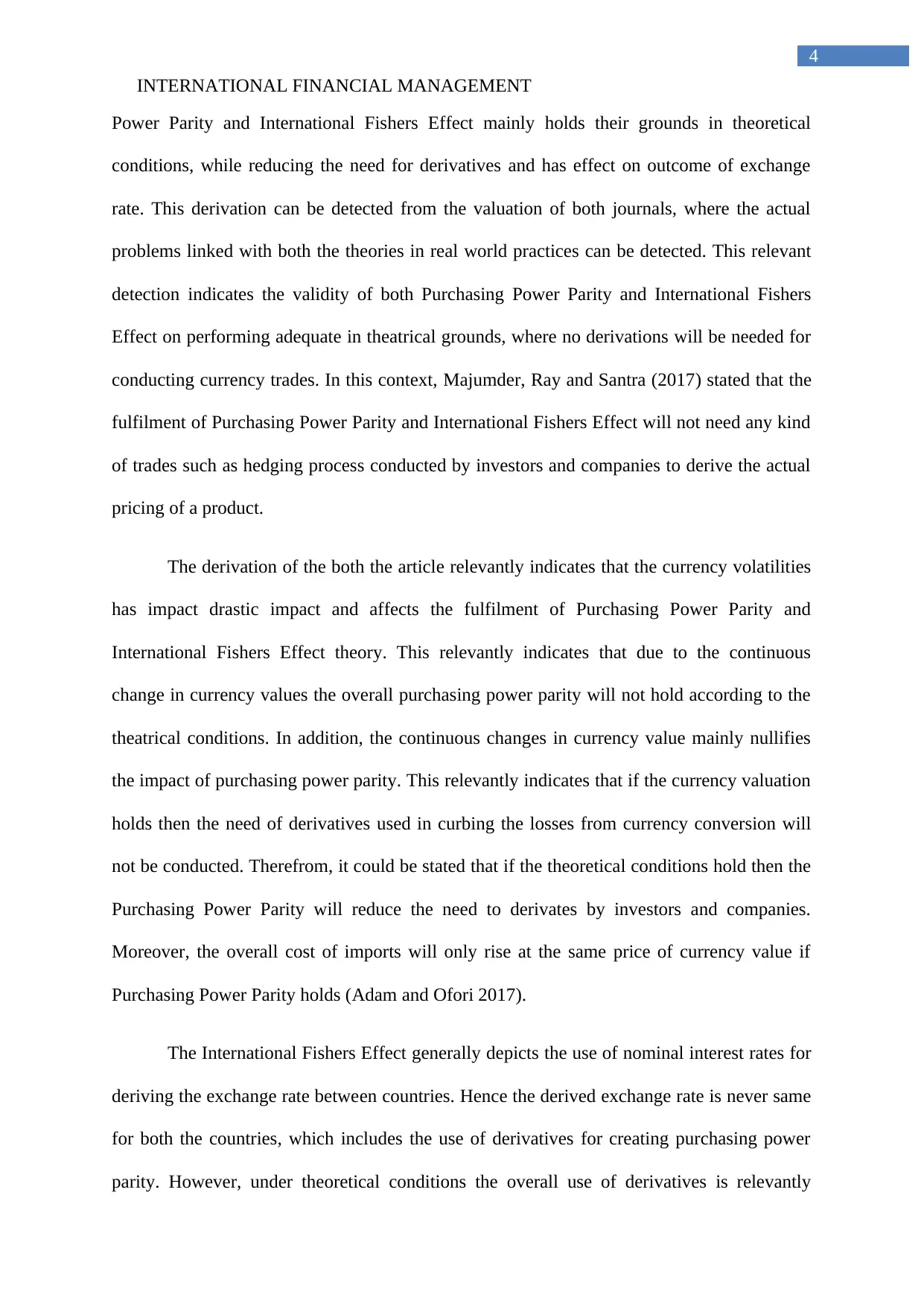
INTERNATIONAL FINANCIAL MANAGEMENT
4
Power Parity and International Fishers Effect mainly holds their grounds in theoretical
conditions, while reducing the need for derivatives and has effect on outcome of exchange
rate. This derivation can be detected from the valuation of both journals, where the actual
problems linked with both the theories in real world practices can be detected. This relevant
detection indicates the validity of both Purchasing Power Parity and International Fishers
Effect on performing adequate in theatrical grounds, where no derivations will be needed for
conducting currency trades. In this context, Majumder, Ray and Santra (2017) stated that the
fulfilment of Purchasing Power Parity and International Fishers Effect will not need any kind
of trades such as hedging process conducted by investors and companies to derive the actual
pricing of a product.
The derivation of the both the article relevantly indicates that the currency volatilities
has impact drastic impact and affects the fulfilment of Purchasing Power Parity and
International Fishers Effect theory. This relevantly indicates that due to the continuous
change in currency values the overall purchasing power parity will not hold according to the
theatrical conditions. In addition, the continuous changes in currency value mainly nullifies
the impact of purchasing power parity. This relevantly indicates that if the currency valuation
holds then the need of derivatives used in curbing the losses from currency conversion will
not be conducted. Therefrom, it could be stated that if the theoretical conditions hold then the
Purchasing Power Parity will reduce the need to derivates by investors and companies.
Moreover, the overall cost of imports will only rise at the same price of currency value if
Purchasing Power Parity holds (Adam and Ofori 2017).
The International Fishers Effect generally depicts the use of nominal interest rates for
deriving the exchange rate between countries. Hence the derived exchange rate is never same
for both the countries, which includes the use of derivatives for creating purchasing power
parity. However, under theoretical conditions the overall use of derivatives is relevantly
4
Power Parity and International Fishers Effect mainly holds their grounds in theoretical
conditions, while reducing the need for derivatives and has effect on outcome of exchange
rate. This derivation can be detected from the valuation of both journals, where the actual
problems linked with both the theories in real world practices can be detected. This relevant
detection indicates the validity of both Purchasing Power Parity and International Fishers
Effect on performing adequate in theatrical grounds, where no derivations will be needed for
conducting currency trades. In this context, Majumder, Ray and Santra (2017) stated that the
fulfilment of Purchasing Power Parity and International Fishers Effect will not need any kind
of trades such as hedging process conducted by investors and companies to derive the actual
pricing of a product.
The derivation of the both the article relevantly indicates that the currency volatilities
has impact drastic impact and affects the fulfilment of Purchasing Power Parity and
International Fishers Effect theory. This relevantly indicates that due to the continuous
change in currency values the overall purchasing power parity will not hold according to the
theatrical conditions. In addition, the continuous changes in currency value mainly nullifies
the impact of purchasing power parity. This relevantly indicates that if the currency valuation
holds then the need of derivatives used in curbing the losses from currency conversion will
not be conducted. Therefrom, it could be stated that if the theoretical conditions hold then the
Purchasing Power Parity will reduce the need to derivates by investors and companies.
Moreover, the overall cost of imports will only rise at the same price of currency value if
Purchasing Power Parity holds (Adam and Ofori 2017).
The International Fishers Effect generally depicts the use of nominal interest rates for
deriving the exchange rate between countries. Hence the derived exchange rate is never same
for both the countries, which includes the use of derivatives for creating purchasing power
parity. However, under theoretical conditions the overall use of derivatives is relevantly

INTERNATIONAL FINANCIAL MANAGEMENT
5
unnecessary, as purchasing the currency conversion will be adequate and has not impact for
external forces (Chi 2016).
5
unnecessary, as purchasing the currency conversion will be adequate and has not impact for
external forces (Chi 2016).
⊘ This is a preview!⊘
Do you want full access?
Subscribe today to unlock all pages.

Trusted by 1+ million students worldwide
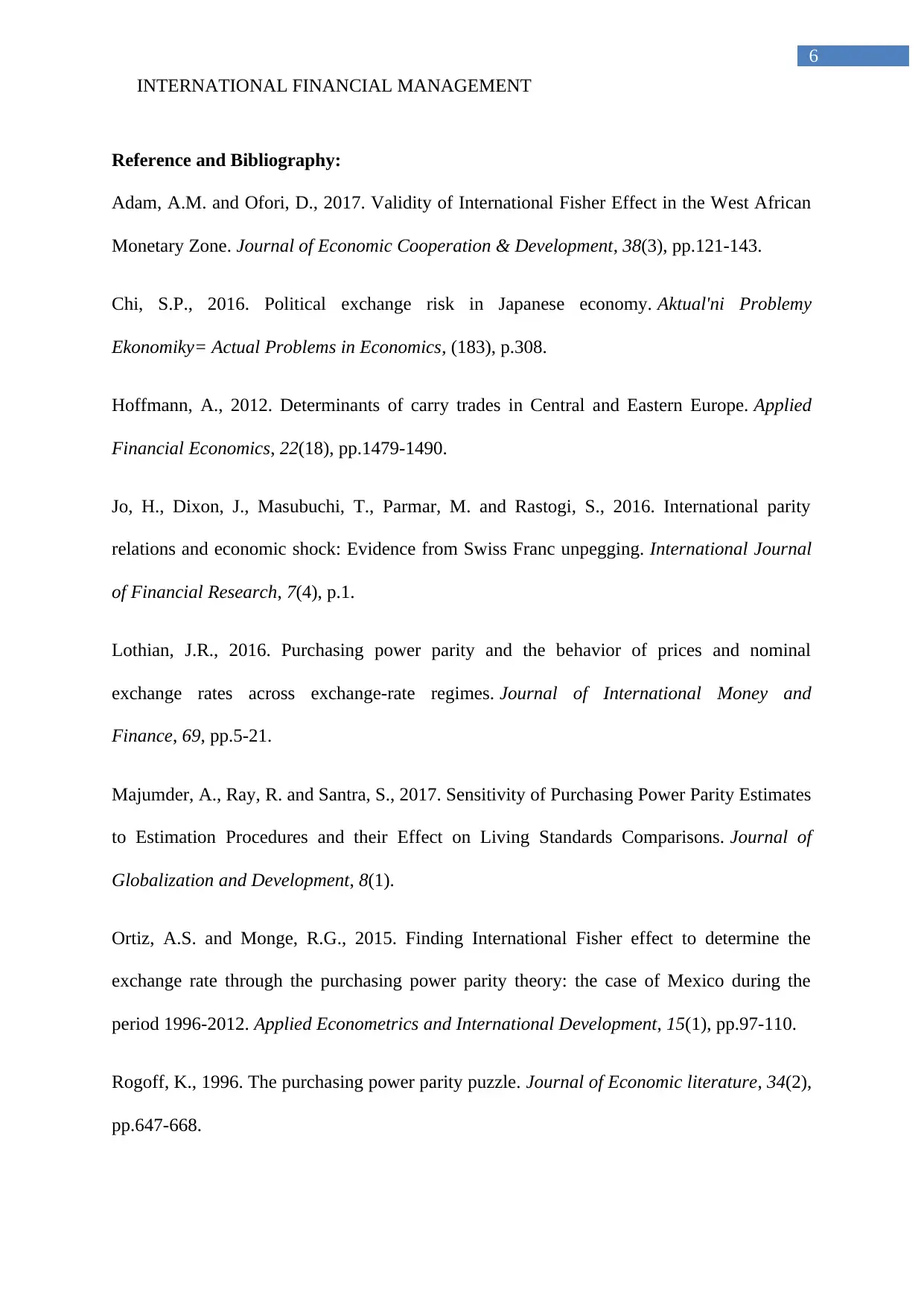
INTERNATIONAL FINANCIAL MANAGEMENT
6
Reference and Bibliography:
Adam, A.M. and Ofori, D., 2017. Validity of International Fisher Effect in the West African
Monetary Zone. Journal of Economic Cooperation & Development, 38(3), pp.121-143.
Chi, S.P., 2016. Political exchange risk in Japanese economy. Aktual'ni Problemy
Ekonomiky= Actual Problems in Economics, (183), p.308.
Hoffmann, A., 2012. Determinants of carry trades in Central and Eastern Europe. Applied
Financial Economics, 22(18), pp.1479-1490.
Jo, H., Dixon, J., Masubuchi, T., Parmar, M. and Rastogi, S., 2016. International parity
relations and economic shock: Evidence from Swiss Franc unpegging. International Journal
of Financial Research, 7(4), p.1.
Lothian, J.R., 2016. Purchasing power parity and the behavior of prices and nominal
exchange rates across exchange-rate regimes. Journal of International Money and
Finance, 69, pp.5-21.
Majumder, A., Ray, R. and Santra, S., 2017. Sensitivity of Purchasing Power Parity Estimates
to Estimation Procedures and their Effect on Living Standards Comparisons. Journal of
Globalization and Development, 8(1).
Ortiz, A.S. and Monge, R.G., 2015. Finding International Fisher effect to determine the
exchange rate through the purchasing power parity theory: the case of Mexico during the
period 1996-2012. Applied Econometrics and International Development, 15(1), pp.97-110.
Rogoff, K., 1996. The purchasing power parity puzzle. Journal of Economic literature, 34(2),
pp.647-668.
6
Reference and Bibliography:
Adam, A.M. and Ofori, D., 2017. Validity of International Fisher Effect in the West African
Monetary Zone. Journal of Economic Cooperation & Development, 38(3), pp.121-143.
Chi, S.P., 2016. Political exchange risk in Japanese economy. Aktual'ni Problemy
Ekonomiky= Actual Problems in Economics, (183), p.308.
Hoffmann, A., 2012. Determinants of carry trades in Central and Eastern Europe. Applied
Financial Economics, 22(18), pp.1479-1490.
Jo, H., Dixon, J., Masubuchi, T., Parmar, M. and Rastogi, S., 2016. International parity
relations and economic shock: Evidence from Swiss Franc unpegging. International Journal
of Financial Research, 7(4), p.1.
Lothian, J.R., 2016. Purchasing power parity and the behavior of prices and nominal
exchange rates across exchange-rate regimes. Journal of International Money and
Finance, 69, pp.5-21.
Majumder, A., Ray, R. and Santra, S., 2017. Sensitivity of Purchasing Power Parity Estimates
to Estimation Procedures and their Effect on Living Standards Comparisons. Journal of
Globalization and Development, 8(1).
Ortiz, A.S. and Monge, R.G., 2015. Finding International Fisher effect to determine the
exchange rate through the purchasing power parity theory: the case of Mexico during the
period 1996-2012. Applied Econometrics and International Development, 15(1), pp.97-110.
Rogoff, K., 1996. The purchasing power parity puzzle. Journal of Economic literature, 34(2),
pp.647-668.
1 out of 7
Related Documents
Your All-in-One AI-Powered Toolkit for Academic Success.
+13062052269
info@desklib.com
Available 24*7 on WhatsApp / Email
![[object Object]](/_next/static/media/star-bottom.7253800d.svg)
Unlock your academic potential
Copyright © 2020–2025 A2Z Services. All Rights Reserved. Developed and managed by ZUCOL.




